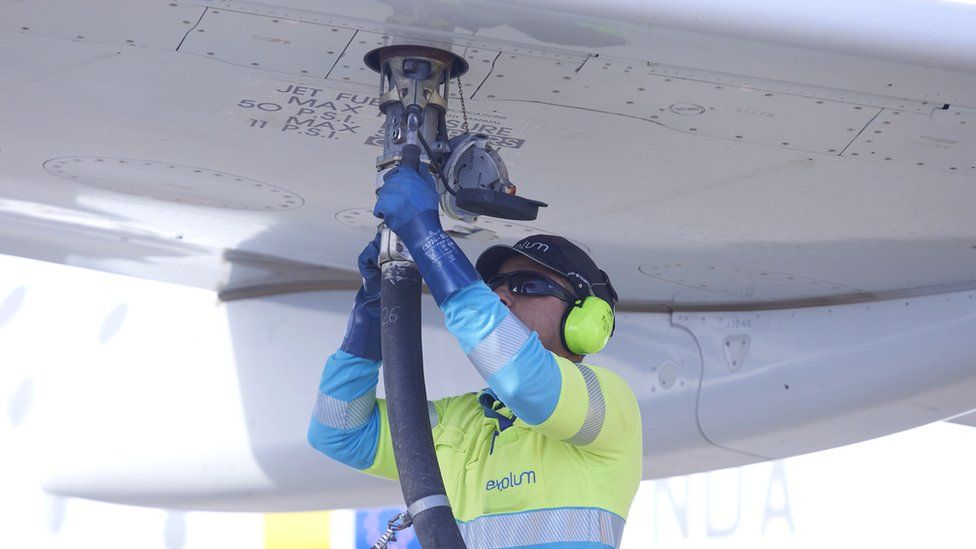ARTICLE AD BOX
 Image source, Getty Images
Image source, Getty Images
Big airports get through millions of litres of jet fuel a day
By Ben Morris
Technology of Business editor
On a typical day 1,300 planes take off and land at Heathrow Airport, and keeping that going requires around 20 million litres of jet fuel every day.
That's the equivalent of filling up your car around 400,000 times.
It's a massive operation, with fuel piped to the airport direct from refineries and then stored at two facilities know as fuel farms.
"The amount of fuel that passes through Heathrow is enormous. It's about half of the UK's jet fuel requirement," says Matt Prescott, head of carbon strategy at Heathrow.
Heathrow Airport itself does not buy and sell fuel, that's down to the airlines and their suppliers.
However, it does have to think about the infrastructure, allotting space for storage and pipes, and making sure the airlines and fuel firms have everything they need.
"It's really about building up the sufficient capacity to ensure that the airport has that resilience built in," says Mr Prescott.
But, when it comes to fuel, airports around the world are having to have a major rethink.
In the UK, under the government's Jet Zero plan, by 2040 the UK aviation industry has committed to achieving net zero carbon emissions.
These are ambitious targets and to reach them will require alternatives to traditional jet fuel.
Image source, Getty Images
Image caption,Sustainable Aviation Fuel is already in use
Sustainable Aviation Fuel (SAF) - fuel that does not come from fossil fuels - is one option. Airlines are already using it, usually blended with regular jet fuel.
For airports it's simple to supply SAF - it can be delivered via existing pipes.
But many doubt whether SAF can be produced cheaply enough, or in large enough quantities, to meet the needs of the airline industry.
So, there is much interest in hydrogen, which can store a lot of energy and, when used as fuel, does not produce any CO2.
To be of any use to the aviation industry, hydrogen needs to be in its liquid form, which involves chilling it to minus 253C.
Handling a liquid at that kind of temperature is immensely challenging. Given the chance, liquid hydrogen will "boil-off" and escape as a gas - potentially becoming a hazard.
So tanks, pipes and hoses all have to be extra-insulated to keep the liquid cold.
Image source, Getty Images
Image caption,Liquid hydrogen is used as fuel on Ariane rockets
France's Air Liquide has a lot of experience in this area. For around 50 years it has been supplying cryogenic hydrogen to the Ariane rockets of the European Space Agency (ESA).
The company produces more than a million tonnes of hydrogen a year and as well as fuelling rockets, its hydrogen is used in trucks and all sorts of industrial processes.
"This gives us a very strong background in technology and industrial knowhow in this field," says Erwin Penforis, a senior executive at the company's global hydrogen business.
Over the past three years, in partnership with Airbus and France's biggest airport operator, Group ADP, Air Liquide has been investigating the potential of hydrogen in the aviation business.
It is also part of the H2Fly consortium which this summer successfully flew an aircraft using liquid hydrogen. For Air Liquide, it was an opportunity to test systems for fuelling a hydrogen aircraft.
Airlines are keen to know if hydrogen planes can be refuelled as quickly and current aircraft, as quick turnaround times are important for the industry.
"Are we able to deliver a few tonnes of liquid hydrogen in a matter of 15 minutes? 20 minutes? We have the technologies for this. We are adapting it - but the answer is yes," says Mr Penforis.
However, installing the equipment needed to store and distribute hydrogen at airports will not be cheap. The consultancy Bain & Company estimates it could cost as much as a billion dollars per airport.
Image source, Universal Hydrogen
Image caption,Universal Hydrogen's module can hold 180kg of liquid hydrogen at minus 253C
One start-up, Universal Hydrogen, says it has a solution. It involves doing all the tricky parts of handling hydrogen away from the airport, probably at the facility where the gas is actually made.
The company has developed special tanks to hold liquid hydrogen (UH calls them modules), which can then be trucked to the airport. The modules are designed to slot straight into the aircraft, where they can be plugged into the propulsion system.
No need for pipes, hoses and pumps.
The modules are extremely well insulated and can keep the hydrogen in its liquid form for four days. Two modules would hold 360kg of hydrogen and would be able to fly an aircraft 500 miles, plus an extra 45 minutes of flight time in reserve.
Universal Hydrogen is modifying a regional airliner, putting in a fuel cell that can convert liquid hydrogen to electricity and connecting that up to electric motors that will drive the propellers.
Larger doors are being fitted so the modules can be loaded into the plane. If all goes to plan, test flights will start next year.
Mark Cousin, chief technology officer, at Universal Hydrogen, says hydrogen is most likely to be used for regional flights, but regular jet fuel will still be needed for long-haul operations.
"Handling the fuel in a different way - like we're proposing - makes sense because you're not trying to convert the existing fuelling infrastructure, which the airlines need to keep anyway for other parts of their fleet," he says.
It's not clear yet whether hydrogen will become a mainstream fuel for aviation. Aircraft powered by hydrogen are still in the early stages of development.
Unlike current planes, which can store fuel in the their wings, hydrogen planes will have to store their fuel in the fuselage, cutting space for passengers.
In addition, there is also the question of whether there will be enough environmentally-friendly, green hydrogen to meet demand.
Image source, Getty Images
Image caption,Hydrogen might not be suitable for long-haul routes
Prakash Dikshit, who works on the planning and development of airports for the consultancy Landrum and Brown, says it's not clear what path the aviation industry will take.
"I think everyone in the aviation industry realises that net zero is something that they need to aspire to. The how we get there, and the economics of getting there are less clear at this point.
"Hydrogen fuelled aircraft - while there might be some demo flights in the next decade, large scale implementation of hydrogen definitely seems farther away. And maybe not even certain."

 1 year ago
38
1 year ago
38








 English (US) ·
English (US) ·